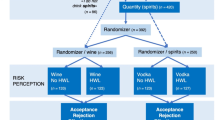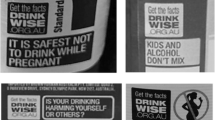Abstract
The Bureau of Alcohol, Tobacco and Firearms (BATF) recently approved two statements that can now be presented on wine bottles to inform consumers about the potential positive health effects of wine consumption. This study examined effects related to the inclusion of a health claim related statement in abetween-subjects experiment involving drinkers and nondrinkers' exposure to manipulated wine labels. The results indicate that consumer attitudes towards the wine product and perceptions of the long-term health effects of wine consumption were influenced by the interaction between the presence of a government warning statement, the availability of a health-effects claim, and drinking status. The implications of these findings for marketers and public policy makers are discussed.
Similar content being viewed by others
REFERENCES
Ajzen, I., & Fishbein, M. (1980). Understanding attitudes and predicting social behavior. Englewood Cliffs, N.J.: Prentice-Hall.
Anderson, J. R. (1983). The architecture of cognition. Cambridge, MA: Harvard University Press.
Andrews, J. C., & Netemeyer, R. G. (1996). Alcohol warning label effects: Socialization, addiction, and public policy issues. In: R. P. Hill (Ed.), Marketing and consumer research in the public interest, pp. 153–175. Newbury Park, CA: Sage.
Andrews, J. C. (1995). The effectiveness of alcohol warning labels: A review and extension. American Behavioral Scientist, 38, 622–632.
Andrews, J. C., Netemeyer, R. G., & Durvasula, S. (1991). Effects of consumption frequency on believability and attitudes toward alcohol warning labels. Journal of Consumer Affairs, 25, 323–338.
Appel, T. (1999). Senator proposing to triple wine tax. Wine Today, February23, retrieved from http://www.winetoday.com.
Barton, J., Chassin, L., Presson, C. C., & Sherman, S. J. (1982). Social image factors as motivators of smoking initiation in early and middle adolescence. Child Development, 53, 1499–1511.
Bensley, L. S., & Wu, R. (1991). The role of psychological reactance in drinking following alcohol prevention messages. Journal of Applied Social Psychology, 21, 1111–1124.
Cantor, J. (1995). National television violence study executive summary 1994–1995. Ventura, CA: Mediascope Inc.
Chaiken, S., & Maheswaran, D. (1991). Promoting systematic processing in lowmotivation settings: Effect of incongruent information on processing and judgment. Journal of Personality and Social Psychology, 61, 13–28.
Charters, S., Lockshin, L., & Unwin, T. (1999). Consumer responses to wine back bottle labels. Journal of Wine Research, 10, 183–196.
Dietary Guidelines for Americans (1996). Washington, DC: U.S. Department of Agriculture, Center for Nutrition Policy and Promotion.
Eigen, L. D., Kellerman, K., Dejong, W., & Hairston, B. (1998). The effects of wine labels on public perception. Washington D.C.: Department of Health and Human Services, Center for Substance Abuse Prevention. Pub. PHD 752.
Engs, R., & Hanson, D. J. (1989). Reactance theory: A test of collegiate drinking. Psychological Reports, 64, 1083–1086.
Fishbein, M., & Ajzen, I. (1975). Belief, attitude, intention, and behavior: An introduction to theory and research. Reading, MA: Addison-Wesley.
Graves, K. L. (1993). An evaluation of the alcohol warning label: A comparison of the United States and Ontario, Canada in 1990 and 1991. Journal of Public Policy & Marketing, 12, 19–29.
Hirschmann, E. C., & Holbrook, M. B. (1982). Hedonic consumption: Emerging concepts, methods and propositions. Journal of Marketing, 46(2), 92–101.
Hyland, M., & Birrell, J. (1979). Government health warnings and the “boomerang” effect. Psychological Reports, 44, 643–647.
Iso-Ahola, S. E., & Crowley, E. D. (1991). Adolescent substance abuse and leisure boredom. Journal of Leisure Research, 23, 260–271.
Kalsher, M. J., Clarke, S. W., & Wogalter, M. S. (1993). Communication of alcohol facts and hazards by a warning poster. Journal of Public Policy & Marketing, 12, 78–94.
Kavanaugh, P. (1998). Speech to the 1998 Annual Impact Marketing Conference. Impact, Vol. 28:20, April 15 and May 1.
Kazman, S. (1999). Here's to honesty in liquor labels. Wall Street Journal, February 18, p. A22.
Kidd, I. (1999). The good, the bad, and the ugly: Branding and packaging can make or break a wine sale. The Australian and New Zealand Wine Industry Journal, 14(6), 80–85.
King, A., Boyce, W., & King, M. (1999). Trends in the health of Canadian youth. Ottawa: Health Canada. Catalogue No. H39–498/1999, E.
Klein, R. (1997). After the preaching: The lure of the taboo. New York Times, August 24, p. 31.
Klein, R. (1993). Cigarettes are sublime. Durham, NC: Duke University Press.
Lavidge, R., & Steiner, G. (1961). A model for predictive measurement of advertising effectiveness. Journal of Marketing, 25(3), 59–62.
Massing, M. (1999). Wines unfortunate new labels. New York Times. February 9, retrieved from http://www.nytimes.com.
Mayer, C. (1999). Message on the bottle: New label's nod to health. Washington Post, February 6, p. E01.
Mazis, M. B., Morris, L. A., & Swasy, J. L. (1991). An evaluation of the alcohol warning label: Initial survey results. Journal of Public Policy and Marketing, 10, 229–241.
Moran, T. (1999). Winemakers toast labels, tackle logistics. The Modesto Bee, February 8, 1999, retrieved from http://www2.modbee.com/pagearc/a30140.htm.
Nunnally, J., & Bernstein, I. H. (1994). Psychometric theory. New York: McGraw-Hill.
Pechmann, C., & Shih, C.-F. (1999). Smoking scenes in movies and antismoking advertisements before movies: Effects on youth. Journal of Marketing, 63(3), 1–13.
Petty, R. E., & Cacioppo, J. T. (1986). Communication and persuasion: Central and peripheral routes to attitude change. New York: Academic Press.
Roe, B., Levy, A. S., & Derby, B. M. (1999). The impact of health claims on consumer search and product evaluation outcomes: Results from FDA experimental data. Journal of Public Policy & Marketing, 18, 89–105.
Scammon, D. L., Mayer, R. N., & Smith, K. R. (1991). Alcohol warnings: How do you know when you have had one too many? Journal of Public Policy and Marketing, 10, 214–288.
Shapiro, M., & Biggers, T. (1987). Emotion-eliciting qualities in the motion picture viewing situation and audience evaluation. Current Research in Film: Audiences, Economics, and Law, 3, 1–11.
Sherif, M., & Hovland, C. I. (1961). Social judgement: Assimilation and contrast effects in communication and attitude change. New Haven, CT: Yale University Press.
Wilde, G. (1998). The concept of target risk and its implications for accident prevention strategies. In: A. M. Feyer & A. Williamson (Eds.), Occupational injury: Risk, prevention and intervention, pp. 82–105. London: Taylor and Francis.
Wine Institute (1999), retrieved from http://www.wineinstitute.org/newstuff.
Zillman, D., & Bryant, J. (1982). Pornography, sexual callousness and the trivialization of rape. Journal of Communication, 32(3), 10–21.
Author information
Authors and Affiliations
Rights and permissions
About this article
Cite this article
Kozup, J., Burton, S. & Creyer, E. A Comparison of Drinkers' and Nondrinkers' Responses to Health-Related Information Presented on Wine Beverage Labels. Journal of Consumer Policy 24, 209–230 (2001). https://doi.org/10.1023/A:1012277421936
Issue Date:
DOI: https://doi.org/10.1023/A:1012277421936




